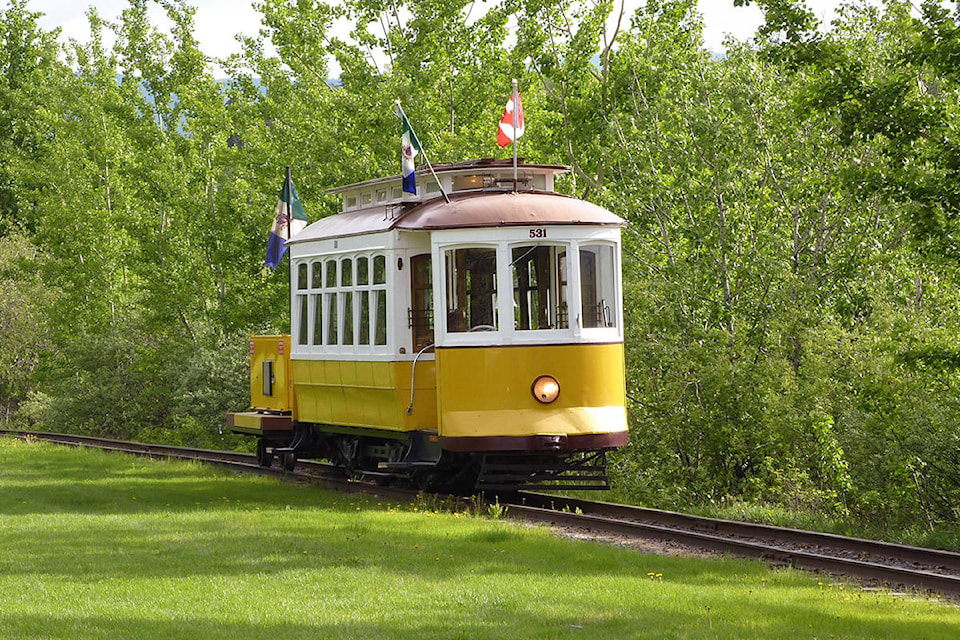Questions about the future of historic rail tracks along the waterfront are being raised as the Whitehorse Waterfront Trolley reaches the end of the line.
It was learned recently the Yukon government is no longer funding the Whitehorse Waterfront Trolley since the three-year agreement for $107,000 annually ended on March 31. MacBride Museum has been running the trolley since 2017 when it took over the Miles Canyon Historic Railway Society, which had been running the service for a number of years.
The end of funding will mean the end of the service.
Shortly after the news broke, speculation erupted on social media that the government was ending funding in order to change the rail right of way for a proposed mixed-use/hotel development being planned next to Kwanlin Dün Cultural Centre.
While the government argues the decision is based entirely on finances, Liz Hanson, NDP MLA for Whitehorse Centre (the riding where the trolley operated), weighed in with a Facebook post expressing her disappointment in the government’s decision.
“Yukon government wants to gut the trolley in order to change the historic White Pass right of way, to allow the hotel development adjacent to KDCC,” she wrote.
River’s Edge Partnership is working on plans for a mixed-use development and hotel on Front Street. Zoning was approved for the plans in the fall of 2018 with officials at that time stating the next step was to look at the financial viability to confirm whether they would move any further with it.
The property line of that site does intersect in some sections with the trolley line though the proposed buildings are planned away from the rails as outlined in city documents when the zoning came forward in the fall of 2018. The trolley line also runs through an adjacent lot owned by the city.
In a May 6 interview, Hanson said she hadn’t seen any formal documents requesting any change to the tracks. She did, however, take issue with the government not addressing the matter and its argument that it’s an economic issue.
“Let’s have an open conversation,” Hanson said, arguing other developments along the waterfront respect easements that are in place.
Highways and Public Works Minister Richard Mostyn reiterated in a May 7 interview the decision to end trolley funding was a financial decision entirely, pointing out the government told MacBride of its decision in a letter dated March 13, 2018 before the zoning came forward for the mixed-use/hotel development. It reminded the museum of that decision in writing again in June and then February.
“It was a hard decision to make,” Mostyn said, pointing out the tracks would require another $1 million in capital funds to fix and that would be on top of any operating expenses. The most recent agreement had seen the government provide $107,000 annually in operational funding with most passengers paying $1 to ride the trolley. MacBride Museum members have their admission to MacBride facilities, including the trolley, covered in their membership fees.
“It comes down to money,” Mostyn said.
It is clear there’s a “strong desire to keep a rail presence” on the waterfront, the minister said, though he did not rule out the possibility of a track realignment in the future, noting that there are some areas where the track bends that could be made safer with some realignment work.
That said, no requests have come forward for a track realignment or to have the tracks moved for any kind of development, he said.
The issue was also broached at council’s May 6 meeting when Coun. Dan Boyd asked staff about the trolley corridor, voicing his opinion the city should encourage the territory to protect the corridor.
The trolley in and of itself may not classify as a piece of Yukon history (coming up to the territory about 20 years ago from Minnesota), but the track is an important part of the territory’s past, he said.
Mike Gau, the city’s director of development services, confirmed there were investments from the federal government, Yukon government, Kwanlin Dün First Nation and the private sector which resulted in the trolley line being part of the redevelopment of the waterfront that got underway about two decades ago.
Mayor Dan Curtis said he’s confident no one is looking to get rid of the rail corridor through the area, though he too commented that track realignment may not be out of the question down the road.
Such realignments have been done in the past, he explained, pointing out it was done when the cultural centre was built. It was clear during zoning discussions on the hotel with developers that there was no desire for the corridor to be removed entirely, he said.
“It would just be a realignment,” Curtis said.
Contact Stephanie Waddell at stephanie.waddell@yukon-news.com
